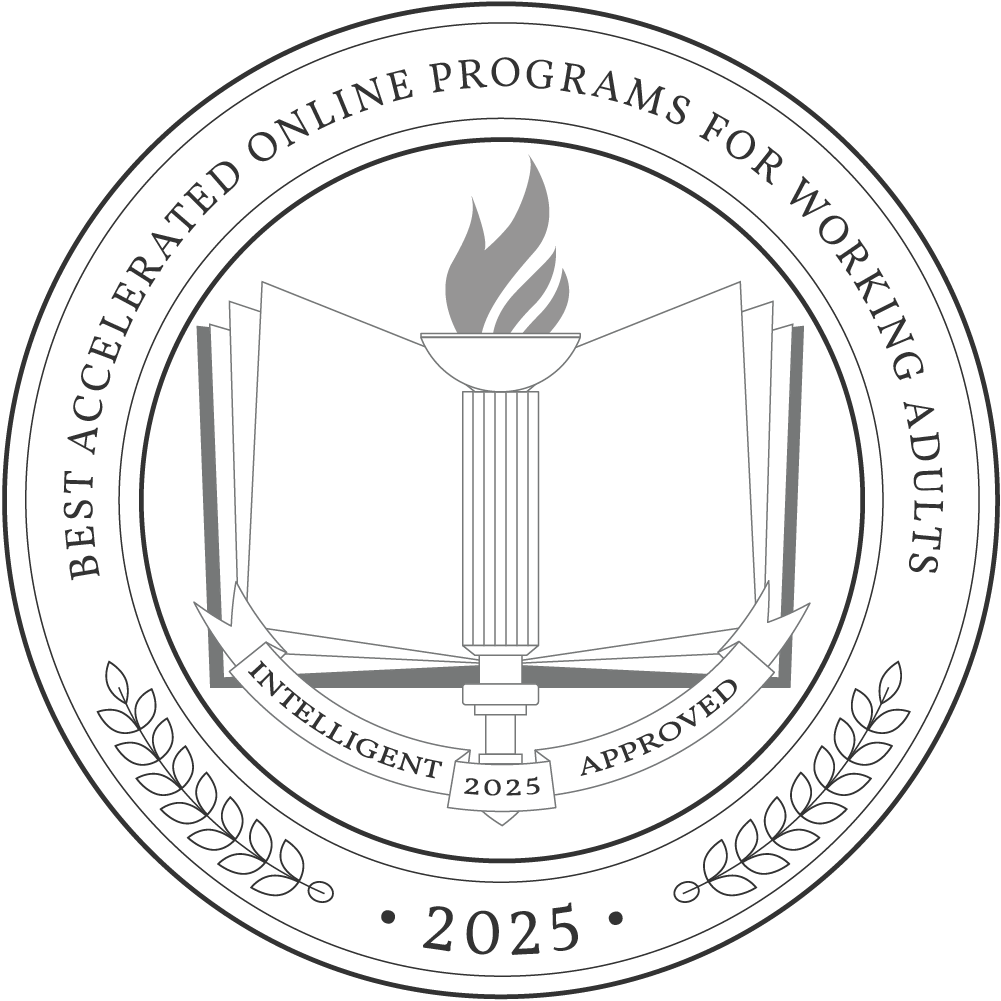Accelerated online degree programs have gained immense popularity as many working adults seek to advance their careers and pursue further education. With the flexibility to study on their schedule, working adults can balance work, family, and other obligations while pursuing their academic goals.
While a traditional bachelor’s degree program takes four years to complete, an accelerated bachelor’s degree program can take anywhere between 1.5 to 3 years to complete, depending on the program and how many credits you take at once.
This article will examine some of the top accelerated online degree programs for working adults, including the difference between synchronous and asynchronous courses. Additionally, we’ll explore study methods and time management techniques that can help working adults succeed in this unique learning environment, enabling them to balance their academic goals with their professional and personal responsibilities.
Synchronous vs. Asynchronous Courses
Synchronous and asynchronous online courses are two different delivery formats for online learning. In synchronous courses, students and instructors participate in real time at scheduled times. In contrast, asynchronous courses do not require scheduled class meetings and allow students to complete coursework independently. Both programs allow students to work from anywhere in the world, as long as they have access to high-speed internet and an up-to-date computer.
Synchronous courses typically require students to log in at specific times to attend live lectures or participate in discussions with their peers and instructors. These courses often have a set schedule and clear deadlines for assignments, quizzes, and exams. While synchronous courses offer the benefit of immediate feedback and interaction with instructors and peers, they can be challenging for working adults with limited flexibility in their work schedules.
On the other hand, asynchronous courses do not have a specific schedule and allow students to complete coursework at their own pace within a set timeframe. This format lets students balance their work and personal responsibilities while completing their coursework. While asynchronous courses may lack the immediate feedback and interaction of synchronous classes, they provide a more self-directed learning experience ideal for working adults who need to fit their education around their work schedule.
For working adults interested in pursuing an online accelerated degree, we recommend that you opt for asynchronous courses whenever possible. Asynchronous courses allow you to complete your coursework at your own pace without the pressure of scheduling conflicts or strict deadlines. This format will enable you to balance your work and education effectively and achieve your degree at an accelerated pace. If you’re unsure of which format would be best for your learning style, connect with an admissions counselor at your school of choice to review more information.
How To Succeed in an Accelerated Degree Program
Returning to school as a working adult can be challenging, especially if pursuing an accelerated degree program. With limited time and competing priorities, developing effective study methods and time management techniques is essential to help you succeed. Whether you’re studying online or in person, these strategies can help you stay on track, manage your time effectively, and achieve your academic goals.
SQ3R Method
The SQ3R method is a study strategy designed to help students read and comprehend textbooks effectively. The acronym stands for Survey, Question, Read, Recite, and Review. Each step guides students through activities that help them actively engage with the text, enhance their comprehension, and retain information.
- Survey: Survey the text before reading it thoroughly. Take a quick look at headings, subheadings, bolded or italicized words, pictures, and any other visual aids in the text. This initial step is intended to give an overview of the text and create a mental framework for understanding it.
- Question: Turn the headings and subheadings into questions. This helps to focus the mind and create a purpose for reading. For example, if the header is “The Causes of Global Warming,” the question could be “What are the causes of global warming?”
- Read: Now, read the text carefully, considering the questions. Take notes while reading, such as writing down definitions, essential facts, or examples.
- Recite: Paraphrase what you have read by summarizing the key ideas in your own words to reinforce understanding and retention.
- Review: Lastly, review the material, ideally within 24 hours of reading it. This could involve reviewing notes, answering study questions, or discussing the material with others.
Feynman Technique
Named after the Nobel Prize-winning physicist Richard Feynman, the Feynman Technique is a study strategy for learning and understanding complex concepts by breaking them down into simple explanations. The technique consists of four steps:
- Choose a concept or idea that you want to understand.
- Explain the concept in your own words, as if you were teaching it to someone with no background knowledge of the subject.
- Identify gaps in your knowledge or understanding and return to the source material to fill in the gaps.
- Simplify and refine your explanation, repeating the process until you can explain the concept in the most straightforward and concise terms.
The Feynman Technique effectively improves comprehension and retention of complex ideas because it forces you to think deeply about the subject and requires you to translate technical language into plain language. Additionally, the technique helps to identify areas where you may have misunderstood the concept or have incomplete knowledge.
Leitner System
The Leitner System, named after its creator, Sebastian Leitner, a German scientist who developed the technique in the 1970s, helps improve long-term retention of information through spaced repetition. Using flashcards, the learner sorts the cards into boxes, each representing a level of knowledge. The boxes are arranged in order of increasing difficulty or familiarity, with the most challenging or unfamiliar cards placed in the first box and the easiest or most familiar cards in the last box.
When studying, the learner reviews the cards in the first box, testing themselves on each card and checking the answer on the other side. If they answer correctly, the card is returned to the first box. Cards already in the last box are considered mastered and need not be reviewed again.
The Leitner System is based on spaced repetition, where information is reviewed continuously over time. By prioritizing review of the most challenging or unfamiliar material and gradually decreasing the frequency of review for mastered material, the learner can optimize their study time and improve long-term retention of information.
Pomodoro Technique
The Pomodoro Technique is a time management method designed to improve productivity and focus by breaking work down into short, timed intervals called “pomodoros.” The technique was developed by Francesco Cirillo in the late 1980s and is named after the tomato-shaped kitchen timer he used to track his work intervals.
The Pomodoro Technique involves the following steps:
- Choose a task to work on and set a timer for 25 minutes, which is one pomodoro.
- Work on the task until the timer goes off without distractions or interruptions.
- Take a short break of three to five minutes after completing the pomodoro.
- After every four pomodoros, take a longer break of 15 to 30 minutes.
This technique is based on the idea that frequent breaks can improve focus and productivity, as well as prevent burnout and fatigue. By breaking work down into short intervals and taking regular breaks, learners can maintain their energy and focus over extended periods of time.
Rapid Planning Method
The Rapid Planning Method (RPM) is a productivity and goal-setting system developed by Tony Robbins, a well-known motivational speaker and life coach. The RPM system is designed to help individuals clarify their goals, prioritize their tasks, and increase their productivity and focus.
The RPR system consists of the following steps:
- Define your outcome: Identify the specific goal or outcome that you want to achieve. This could be a long-term goal or a particular project or task.
- Create a massive action plan: Brainstorm all the tasks and actions necessary to achieve your outcome. Then, organize these tasks into categories and create a list of action steps.
- Identify your focus areas: Identify the areas of your life or work most important to achieving your outcome. These could be specific projects, relationships, or personal development areas.
- Create a weekly plan: Break down your massive action plan into weekly tasks and identify the specific actions you need to take in each focus area.
- Review and adjust: Regularly review your progress and adjust your plan as necessary. This will help you stay on track and make sure that you are making progress toward your outcome.
Focusing on the most critical areas of your life and work and taking consistent action toward your goals can achieve tremendous success and fulfillment.
Our Research
This list features some of the country’s best accelerated online degree programs for working adults. Each school featured is a nonprofit, accredited institution, either public or private, with a high standard of academic quality for post-secondary institutions.
We evaluated each school’s program on tuition costs, admission, retention and graduation rates, faculty, and reputation. Then, we calculated the Intelligent Score on a scale of 0 to 100. Read more about our ranking methodology.
Next, we compared this comprehensive list of the best accelerated online degree programs for working adults to a list of aggregated college rankings from reputable publications, such as U.S. News & World Report, to simplify a student’s college search. We pored through these rankings so students don’t have to.
The 50 Best Accelerated Online Degree Programs For Working Adults


